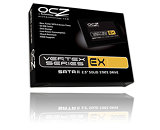malware
New Member
- Joined
- Nov 7, 2004
- Messages
- 5,422 (0.73/day)
- Location
- Bulgaria
| Processor | Intel Core 2 Quad Q6600 G0 VID: 1.2125 |
|---|---|
| Motherboard | GIGABYTE GA-P35-DS3P rev.2.0 |
| Cooling | Thermalright Ultra-120 eXtreme + Noctua NF-S12 Fan |
| Memory | 4x1 GB PQI DDR2 PC2-6400 |
| Video Card(s) | Colorful iGame Radeon HD 4890 1 GB GDDR5 |
| Storage | 2x 500 GB Seagate Barracuda 7200.11 32 MB RAID0 |
| Display(s) | BenQ G2400W 24-inch WideScreen LCD |
| Case | Cooler Master COSMOS RC-1000 (sold), Cooler Master HAF-932 (delivered) |
| Audio Device(s) | Creative X-Fi XtremeMusic + Logitech Z-5500 Digital THX |
| Power Supply | Chieftec CFT-1000G-DF 1kW |
| Software | Laptop: Lenovo 3000 N200 C2DT2310/3GB/120GB/GF7300/15.4"/Razer |
OCZ Technology Group, Inc., a worldwide leader in innovative, ultra-high performance and high reliability memory and computer components, today unveiled OCZ Vertex EX 2.5" Solid State Drives that is designed to meet the stringent demands of server environments and enterprise applications. These new premium offerings are the pinnacle storage option excelling in performance, reliability, and power consumption that offer professionals and enthusiasts an unparalleled computing experience.


"The advantages of SSD's over traditional hard disc drives including performance, reliability, no cooling requirements, and lower power consumption, are all highly beneficial to enterprise applications and enthusiast consumers looking for the ultimate storage solution," commented Alex Mei, CMO of the OCZ Technology Group. "The new OCZ Vertex EX is designed to deliver unparalleled performance and reliability, featuring the latest-generation architecture and SATA interface utilizing single-level cell NAND flash memory for unmatched overall system responsiveness and stability for enterprise grade server solutions."
Offering a server-class storage upgrade from traditional hard disc drives, OCZ Vertex EX SSDs have a compact form factor and no moving parts resulting in a quiet storage solution with significantly higher performance. For crowded server environments, the OCZ Vertex EX SSDs offer space and cost-savings with a compact form factor that use significantly less power thanks to the benefits of high-quality flash-based storage.
OCZ continues to expand its reach to all areas of computing interests and system preferences by going beyond the enthusiast PC to professional server and workstations. Building on the advantages of SLC flash-based storage, the OCZ Vertex Series EX is the result of the latest breakthroughs in SSD technology, delivering incredible performance that translates to professional-class data storage enthusiasts have come to expect from OCZ's premium Solid State Drive offerings. These next-generation drives feature speeds up to a 260 MB/s read and 210 MB/s, while delivering lowered power consumption, increased responsiveness and data access, and superior durability compared to conventional hard drives. Initially available in capacities of 60 GB and 120 GB, Vertex EX offers ample room to create the ideal storage array for all your data.
For more information on the OCZ Vertex EX SSD, please click here.
View at TechPowerUp Main Site


"The advantages of SSD's over traditional hard disc drives including performance, reliability, no cooling requirements, and lower power consumption, are all highly beneficial to enterprise applications and enthusiast consumers looking for the ultimate storage solution," commented Alex Mei, CMO of the OCZ Technology Group. "The new OCZ Vertex EX is designed to deliver unparalleled performance and reliability, featuring the latest-generation architecture and SATA interface utilizing single-level cell NAND flash memory for unmatched overall system responsiveness and stability for enterprise grade server solutions."
Offering a server-class storage upgrade from traditional hard disc drives, OCZ Vertex EX SSDs have a compact form factor and no moving parts resulting in a quiet storage solution with significantly higher performance. For crowded server environments, the OCZ Vertex EX SSDs offer space and cost-savings with a compact form factor that use significantly less power thanks to the benefits of high-quality flash-based storage.
OCZ continues to expand its reach to all areas of computing interests and system preferences by going beyond the enthusiast PC to professional server and workstations. Building on the advantages of SLC flash-based storage, the OCZ Vertex Series EX is the result of the latest breakthroughs in SSD technology, delivering incredible performance that translates to professional-class data storage enthusiasts have come to expect from OCZ's premium Solid State Drive offerings. These next-generation drives feature speeds up to a 260 MB/s read and 210 MB/s, while delivering lowered power consumption, increased responsiveness and data access, and superior durability compared to conventional hard drives. Initially available in capacities of 60 GB and 120 GB, Vertex EX offers ample room to create the ideal storage array for all your data.
For more information on the OCZ Vertex EX SSD, please click here.
View at TechPowerUp Main Site


 must be crazy!
must be crazy!



 ...
... !
!